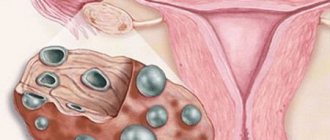Currently, cervical erosion is one of the most common diseases of the female reproductive system. It is characterized by damage to epithelial cells as a result of injury, surgery or an infectious disease.
There are several types of treatment for erosion, including cauterization. But this method is not suitable for all women. Does cauterization of cervical erosion have consequences in nulliparous girls? What alternative therapies are there? All this will be discussed in this article.
Description of the disease
The entire area of the cervical canal of the uterus is covered with epithelium inside and outside. The type of mucous membrane inside the cervix and on the outer part that goes into the vagina differs. When micro-wounds form in the area of the epithelium leading to the vagina, and particles of epithelial cells from the inside of the cervix fall on them, erosion appears. The extraneous epithelium actively grows, narrowing and blocking the opening of the cervical canal. Thus, untreated cervical erosion can lead to the inability to conceive and even cervical cancer.
Types of erosion
There are several types of damage to the mucous membrane in the cervical canal of the uterus:
- Congenital ectopia or “false” erosion is a small spot of bright red color with clear edges. The pathology is typical for young girls under 18 years of age. This is a benign neoplasm and does not require treatment. But it is recommended to go to the gynecologist for check-ups at least twice a year.
- True erosion is damage to the flat multilayered mucous membrane due to injury or an inflammatory process. This is a red, rounded spot with clearly defined boundaries. The illness period is about two weeks. Then it transforms into a state of ectopia.
- Epitheal ectopia is a mixture of columnar and squamous epithelium on the wall of the cervix. Ectopia does not go away on its own and requires treatment. Against the background of this pathology, a cancerous tumor may develop. If oncogenic human papillomavirus cells are found, the risk of cervical cancer increases.
During a gynecological examination, the doctor can identify what type of erosion a woman has. The most common manifestation is epithelial ectopia, which needs to be observed and treated.
Chemical coagulation
This method is widely used by many doctors as it does not require expensive equipment. Its use is indicated for minor damage - less than a 2-kopeck coin. The eroded areas are treated with special preparations (for example, Solkovagin, Vagotil), which destroy the columnar epithelium. Treatment is long and requires several (up to five) procedures. But this method does not guarantee complete recovery.
Some women use "grandmother" methods of treatment. Various lotions and douching with sea buckthorn oil, nettle, etc. may not only not cure, but also worsen the condition of the tissues. In this case, it is discovered that the wound from above is healing, but will develop in depth. Therefore, you should not experiment.
All these cauterization methods are carried out only after menstruation. Until complete recovery, it is not recommended, and sometimes even prohibited, to have sex, swim in reservoirs, take baths, and prolonged overheating of the body.
Causes of pathology in nulliparous women
There are a number of factors for cervical ectopia. Including nulliparous women. This:
- instability of sexual life, early or late onset;
- chlamydia, trichomoniasis infection, abnormal vaginal microflora;
- human papillomavirus, syphilis;
- mechanical injuries due to abortion or miscarriage;
- pathology of the endocrine system, unstable menstruation;
- low immunity.
Treatment of the pathology depends on the reasons that provoked it. After an examination and epithelial analysis, the doctor prescribes therapy.
Main symptoms
Most often, erosion in women does not make itself felt. Sometimes there is discharge or unpleasant pain during menstruation, no more. But it happens that the disease manifests itself with the following symptoms:
- painful sensations during sexual intercourse or immediately after it. Feels like pain during menstruation;
- brownish or bloody discharge after sexual intercourse;
- strong white-milky discharge during the entire period of menstruation;
- leucorrhoea that accompanies a woman throughout her menstrual cycle;
- frequently recurring thrush.
Sometimes, erosion is completely asymptomatic, and a woman finds out that she is sick during a routine examination by a doctor. In order to detect the disease in time and begin to treat it, a nulliparous woman needs to visit a gynecologist once every six months.
Laser
Laser treatment of eroded surfaces is a modern method. It is considered effective and least dangerous. However, laser therapy can only be carried out in some clinics, as it requires quite expensive equipment. In essence, the area of erosion is targeted by a laser beam. At the same time, the depth of destruction is monitored. There is no scarring, but doctors are of the opinion that this procedure is not suitable for nulliparous women.
Diagnostics
Erosion can be diagnosed through a gynecological examination with speculum. The affected mucosal area has a bright red color and a granular structure.
To study the pathology in detail and determine whether it is benign or malignant, the doctor performs colposcopy and biopsy. Under a colposcope, a small piece of epithelium is carefully examined. This way the type of disease is determined. A biopsy determines the presence of cancer cells in the epithelium. To do this, a piece of tissue is taken. The final stage of diagnosis is taking smears for the presence of STIs, HPV and the state of the vaginal microflora.
Treatment methods
Treatment methods for erosion are varied and depend on its type, size, and whether the woman has given birth or not. How is uterine erosion treated in nulliparous women:
- Hormonal and drug therapy. Antimicrobial, wound-healing agents, tampons and suppositories are prescribed.
- Chemicals. Treatment is indicated if there are condylomas and superficial growths on the mucous membrane.
- Electrocoagulation. The growth is cauterized using electric current. This method is recommended for women during menopause, because it leaves scars on the cervix and the tissue becomes rough. This carries complications during pregnancy and childbirth.
- Cryotherapy. The erosion is cauterized with liquid nitrogen, leaving no scars on the mucous membrane of the cervix.
- Laser therapy. Cauterization with laser. The procedure is painless and leaves no traces. The laser acts only locally, without affecting healthy epithelium. It is used for both women who have given birth and women who have not given birth.
- With a radio knife. Using radio waves, the affected part of the epithelium is cut out and removed. Recommended if tissues are deeply damaged and cervical cancer is suspected.
- Surgical intervention. Complete cervical canal of the uterus using excision. It is carried out in the presence of cancer cells. The operation is performed with a radio knife or surgical scalpel.
Should I be afraid of ectopia?
It is imperative to treat cervical erosion in a timely manner and not to advance the disease. This also applies to nulliparous women. Since untreated erosion can lead to serious complications in a nulliparous girl. The main thing is infertility. There is a risk that the elasticity of the cervical canal will gradually decrease, and difficulties may arise during pregnancy and childbirth. Such as:
- suffocation of the fetus when it passes through the cervical canal, which has lost its elasticity;
- rupture of the hardened part of the epithelium during childbirth and the risk of infection with STIs, HPV and other viral diseases;
- if the tissues are torn during gestation, there is a risk of miscarriage or intrauterine infection and death;
- the threat of magnetization of the damaged area of the mucous layer. That is, its transformation into a malignant neoplasm;
At the same time, every year the percentage of cervical cancer due to untreated erosion is increasing. Therefore, it is important for every woman to remember the need to treat ectopia in a timely manner.
To treat or not
Whether erosion needs to be treated depends on its type. For example, congenital erosion does not cause complications and does not require treatment. It goes away with age.
But treatment is mandatory for epithelial ectopia, since further transformation of the epithelium can lead to infertility or cervical cancer.
Cryotherapy
This method is based on the action of liquid nitrogen on tissue, while tissue susceptible to erosion is destroyed by the flow of this substance from the cryoprobe. The point of application is selected very precisely, and virtually healthy tissue is not affected, and scar damage does not form on the cervix. The procedure does not last long. It’s painless, you just feel like something is happening inside, and your stomach may tug a little. There is no smell. After the procedure, you may feel a little dizzy: this is the effect of nitrogen. However, after two weeks there may be some discharge. This method is bloodless and very gentle. But this is not always applicable in cases of erosion affecting the underlying tissue.
How to treat cervical erosion in nulliparous women
Treatment methods for erosion in nulliparous women are mostly conservative. Drug therapy used:
- Antimicrobial drugs.
- Drugs for regulating immunity.
- Suppositories - suppositories for erosion.
- Chemicals for burning out erosion.
These treatments are used for young women because they do not leave marks or damage that could prevent them from becoming pregnant and giving birth in the future. If the lesion is large, then doctors cauterize the erosion of the cervix, using methods that do not leave marks or hardened areas of tissue.
Medicines
Drug treatment is aimed at treating concomitant pathologies, preventing infection, and normalizing the menstrual cycle. The doctor prescribes the following medications for cervical erosion:
- antibiotics;
- antifungal agents;
- anti-infective drugs;
- hormonal;
- means that strengthen the immune system.
Drug treatment is used as an auxiliary treatment and cannot completely eliminate erosion.
Tampons
This type of treatment helps with small lesions; tampons heal wounds and prevent inflammatory processes.
You can make tampons yourself or buy regular ones at the pharmacy. Recipes for tampons for the treatment of erosion:
- Tampon with sea buckthorn oil. Pour some oil into a bowl. And soak the tampon well with it. Place in the vagina overnight. So, ten days without a break. The oil has wound healing and restorative properties.
- With aloe leaves. Pre-cut the aloe leaves and keep in the refrigerator for five days. Then, rinse them thoroughly with running water and peel them. Grind the leaves and make a gauze pad. Place the tampon until the morning. The course of treatment is 10 days.
- Onion tampons. Chop one medium-sized onion on a fine grater. Wrap the pulp in sterile gauze. Leave it on all night. During treatment there will be a burning sensation, which must be endured. Duration of therapy is a week.
- Tampons with propolis. Take natural propolis. It’s best not from a pharmacy, but from an apiary. Heat a small piece of propolis in a water bath. Moisten the tampon generously in the resulting slurry. Put it to sleep until the morning. The course of treatment is ten days.
Chemical exposure
The use of chemicals for cauterization is a common practice. The lesion is treated with a mixture of Solkovagin or Vagotil acids. They burn out the overgrown mucous layer. This method is cyclic; to completely get rid of erosion you will need five to six cauterizations. The treatment plan and drug are selected by the doctor based on the individual indications and condition of the patient. The healing time of a wound depends on the characteristics of the body. This technique does not guarantee a complete cure and is suitable for removing small erosions.
Laser exposure
Not long ago, doctors began using laser vaporization for treatment. This is one of the most effective and safe methods. Using a combination of two types of laser exposure, it is possible to completely destroy the overgrown layer of epithelium. The procedure is carried out through a video colposcope, the doctor fully controls the entire process.
Laser vaporization creates a wound that heals in about four weeks without leaving any scars. Gynecologists use this method of treating cervical erosion in nulliparous girls for large lesions when other methods have failed. Because the procedure is not cheap.
Recipes for oral administration
Decoctions and tinctures of herbs help cure erosion. They strengthen the immune system and help tissues recover faster from the inside. What decoctions are prepared from:
- Yarrow. For a liter of water, two spoons of inflorescences. Keep on medium heat for twenty minutes. Take instead of tea, you can add sugar or honey for taste.
- Millet. For 250 ml of water, 1.5 tablespoons of washed millet cereal. Take half a glass in the morning, afternoon and evening.
- Bedstraw. For one glass of boiling water 10 g. herbs. Leave for about three hours. Dosage: 100 ml of heated decoction before each meal.
- Pumpkin seeds. The seeds need to be ground through a blender or meat grinder. And pour boiling water in a ratio of 1:2. Leave overnight. Strain the resulting tincture and drink 100 ml once a day.
Causes
The exact cause of the defect in the cervical mucosa is unknown. However, there are a number of reasons that lead to this disease. Erosion can be caused by:
• trauma (intercourse, incorrect insertion of a tampon, foreign objects in the vagina, abortion, childbirth, injuries during sex); • infection (herpes, syphilis, tampons that were not removed on time, severe vaginal infections); • exposure to chemicals (contraceptive creams or ointments, shower gel or foam).
There is an increased risk associated with vaginal use of chemical agents or having multiple sexual partners. However, in most cases, this condition is observed in women without the above risk factors. Early sexual activity has a negative effect on the mucous membrane. And in conditions of weakened immunity, the aggressiveness of infections leads to many diseases. Treatment of cervical erosion in nulliparous women should begin with finding out the cause of this condition.











